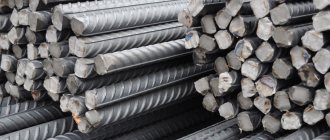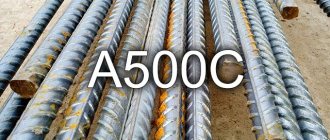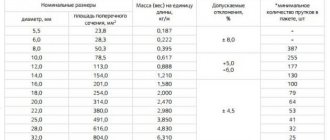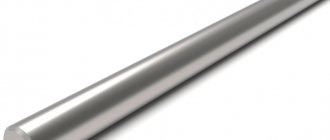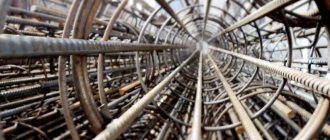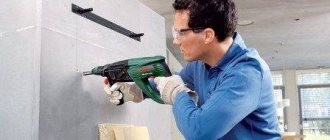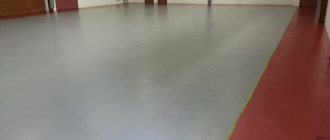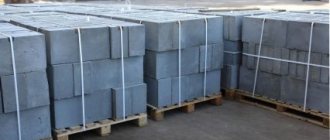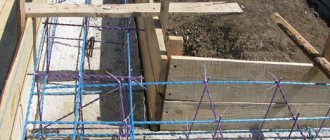- Long products
January 30, 2020
1139
Reinforcing steel of class A III (A3 reinforcement) is one of the varieties of long-rolled black steel. As a rule, with a periodic profile, transverse protrusions of a certain shape and longitudinally located ribs. That is why the reinforcement is sometimes called A3 corrugated.
A3 fittings what is it
Corrugated reinforcement A3 is an outdated name for one of the varieties of rolled metal products. It was previously produced in accordance with GOST 5781 82. This regulatory document has now been replaced, but is still used in the sale of metal products. A similar statement applies to GOST 10884-94, also replaced. They were replaced by GOST 34028-2016. In addition, the national GOST R 52544-2006 and a number of technical conditions are in force in Russia. For example, we note TU 14-1-5627-2012, TU 14-1-5543-2017, TU 14-1-5254-2006, others. And the use of the type of rental in question is regulated by the set of rules SP 63.13330.2018.
To understand now what type of rolled metal A3 reinforcement is, we should consider the norms of the specified regulatory documents. Based on the performance characteristics and other parameters of class A reinforcing steel, a number of metal products now correspond to class A III. These are fittings A400, A500, B500, including their varieties A400s, At400, A400K, A500C, B500C, and others.
The name of this type of long products indicates:
- production technology (hot rolled (A) or cold rolled (B));
- yield strength (respectively 400 N/mm² or 500 N/mm²);
- an additional set of technical requirements (for example, C - welded).
Please take this into account when purchasing. We'll talk more later.
Table of assortment and weight of reinforcement A3 (A400)
When purchasing and calculating the consumption of fittings, it is necessary to know not only its length but also its weight; the table below presents a list of all diameters of A400 fittings and their weight.
| Rod diameter, mm | Weight of 1 meter of A3 reinforcement, kg |
| 6 | 0,22 |
| 8 | 0,4 |
| 10 | 0,62 |
| 12 | 0,89 |
| 14 | 1,2 |
| 16 | 1,6 |
| 18 | 2,000 |
| 20 | 2,5 |
| 22 | 3 |
| 25 | 3,8 |
| 28 | 4,8 |
| 32 | 6,3 |
| 36 | 8 |
| 40 | 9,9 |
AIII fittings according to GOST 5781-82
GOST 5781-82 has been cancelled, but it is still actively used by some metal depots when selling A3 class reinforcing steel. Therefore, let us consider this document, which regulates the use of hot-rolled steel for the reinforcement of various reinforced concrete structures, in more detail.
Let's start with the fact that the A3 reinforcement is corrugated, that is, with a periodic type of round profile. There are ribs (a pair located longitudinally) and protrusions located transversely, passing along a helical line (three-way). It is worth clarifying that for products with a diameter of 6.00 mm the line is single-pass. For rolled products with a diameter of 8.00 mm, a double-entry line is allowed.
Rolled products are produced (let's just say they were produced, we will adhere to the current regulatory documents) in coils or rods (rods). More precisely, with a diameter of up to 10.00 mm, it is offered in coils or rods. Everything above is only in rods. Please keep this fact in mind when purchasing, delivering, loading, unloading and using. The profile number (its nominal diameter) is from 6.00 to 80.00 mm (in practice from 6.00 to 40.00 mm). Cross-section area from 0.283 to 50.270 cm³. Rod length is from 6.00 to 12.00 meters. It can be measured, and also unmeasured, and the third type is measured with certain unmeasured segments and lengths. If you need shorter rods, check to see if the supplier offers cutting services. This means cutting into fragments designated by the buyer.
Steel grades
Corrugated fittings A3 (aka A400) were made from carbon steel. These are brands such as 25G2S, and also 32G2Rps and often 35GS.
Steel 25G2S belongs to the category of structural, low-alloy steel, intended for welded various structures. That is, 25G2S reinforcement is welded well using various types of welding. The design resistance of this steel grade is identical to 35GS. Allowed for use at temperatures down to -70º C. Forging at a temperature of approximately + 1200º C with a gradual decrease to 850º C, not flake-sensitive, not prone to temper brittleness.
35GS fittings are made from 35GS steel grade. It also belongs to the category of structural, low-alloy, used in welded structures. Widely used previously. Now its use is gradually being abandoned, replaced by analogues St3SP, St3PS and St3GPS, from which the A500C fittings are made.
32G2Rps is the third type of carbon low-alloy steel grade. The 32G2Rps fittings also belong to the welded group. Steel 32G2Rps was used in the production of this type of long products such as A3 reinforcement. Please note that this grade of steel may have a different composition of alloying components. Aluminum can be replaced with titanium or zirconium, in similar units. Titanium can be added to steel grades 25G2S and 35GS. Due to the variability of the chemical composition, the performance characteristics change; they must be taken into account when designing reinforced concrete structures being erected.
Production technology
There is only one production technology for class AIII reinforcing steel according to GOST 5781 82 - hot rolling. It consists of rolling and shaping a preheated billet through the rolls of a rolling mill. Then cutting and, if necessary, additional processing is carried out. We are talking about low-temperature tempering and thermomechanical processing. Although these are uncharacteristic operations for class A3.
The main operating parameters are as follows:
- yield limit, (N/mm²)/(kgf/mm²) – 390/40;
- temporary tensile strength, (N/mm²)/(kgf/mm²) – 590/60;
- elongation, relative, % – 14.
When making a purchase, pay attention to the availability of accompanying documents. There must be a certificate, the profile number, its class and a number of other parameters are indicated. By class we mean AIII or taking into account the yield strength A400.
A little about specialized varieties
Conventional A3 reinforcement is used for simple construction. However, specialized varieties are also produced, used only in relatively rare cases. You should also know about them:
- AT400 are special rods that have undergone additional heat treatment. Due to the effect on the crystal lattice of the metal, this treatment significantly increases strength without increasing the diameter;
- A400C fittings are a special type of rods that can be welded. Usually, in the manufacture of frames for construction, a special knitting wire is used - welding is not used. A sharp increase in temperature by hundreds of degrees damages the crystalline structure of the metal, reducing its strength - under significant loads, overheated areas break first. In addition, corrosion develops much faster on them, which significantly reduces their service life. But the special A400C is devoid of such disadvantages and is connected both with knitting wire and by welding;
- A400K is a highly specialized material that is not subject to corrosion. Special processing and the use of carefully selected additives improve corrosion resistance. It is widely used in the manufacture of dams, bridge foundations, as well as foundations with high groundwater levels.
It is worth noting that A3 reinforcement may contain various impurities. Moreover, this applies to both specialized varieties and ordinary ones. The composition includes: carbon, silicon, manganese, chromium, copper, aluminum, nickel, sulfur, copper and phosphorus.
Of course, the mass fraction of these additives is measured in hundredths and even thousandths of a percent. They are regulated by GOST developed for A3 fittings - the slightest violation of the recipe worsens the technical characteristics of the finished product. But if the proportions are observed, it can significantly increase the strength, frost resistance and other important qualities of the rods.
At400 and At500 fittings according to GOST 10884-94
The second regulatory act that we will consider in our article is GOST 10884-94. That too has now been cancelled. It predetermines the production of thermally strengthened reinforcing steel, used in the reinforcement of reinforced concrete structures. They already mentioned her in passing.
Reinforcement A3 according to fluidity class A400. Based on this. To make the picture complete, mention should be made of this type of rolled product such as At400 and At500 reinforcement. It is precisely the index “t” that indicates that the reinforcing steel is thermally strengthened. That is, it was obtained by hot rolling (index “A”). One more clarification regarding the name. There may be a letter after the number. For example, At400S, where “C” indicates that the rolled metal is weldable. The index “K” means that we have products that are resistant to corrosion cracking.
Thermal hardening should be understood as high-temperature thermomechanical treatment. To make it simpler and without abstruse terms. Hot rolling technology involves heating and shaping the workpiece. After the workpiece passes through the rolling mill and a rod is obtained, it is forcedly cooled. Moreover, this is an accelerated process of controlled cooling that occurs after hot deformation of the workpiece. It is called hardening. Quite simply, the hot workpiece is immersed in a bath of water for a few seconds. Additional operations such as tempering or self-tempering may then be performed, followed by slow cooling. As a result, the plasticity of products, their strength and resistance to destruction increase. If it’s really smart, then this happens due to a more uniform distribution of the strengthening phases. Moreover, thanks to the formation of the structure of dynamic polygonization of austenite.
As in GOST 5781-82, it is indicated that this is corrugated rolled metal. It can be either with two longitudinally located ribs or without them. Plus transverse protrusions, crescent-shaped, passing along a multi-entry helical line. We'll talk about profile types a little later.
Now about the assortment
The diameter, meaning nominal, of thermally strengthened rolled products is from 6.00 to 40.00 mm. The form of production is coils for rolling with a diameter of 6.00 and 8.00 mm, everything over 10.00 mm is produced in rods (rods). The regulatory document under consideration stated that thermally strengthened reinforcing steel At400S and At500S with a nominal diameter of 10.00 mm can be produced in coils. Coils are usually sold by weight up to 3.00 tons. The rods are sold in lengths from 5.30 to 13.50 meters. It is allowed to produce this type of long products with a length of 26.00 m. Manufacturers produce reinforcing steel according to the length specified by the buyer. Or you can cut it at a metal scrapyard if necessary. Moreover, the length can be measured, measured with unmeasured segments, or unmeasured (from 6.00 to 12.00 m). The marking indicates the class (yield strength) and nominal diameter. Operational parameters are also indicated (weldable, corrosion-resistant or not). As an example, 10At400C. Reinforcing steel with a nominal diameter of 10.00 mm, heat-strengthened, class 400, weldable.
Heat-strengthened products are produced from low-alloy (with the addition of alloying components) and carbon steels. At400S fittings are made from steel grades St3PS, and also St3SP. But the At500S reinforcement with increased yield strength from St5SP and St5PS. These are carbon steel grades. A two-letter index indicates the degree of deoxidation. SP – mild steel, PS – semi-mild steel. 3 or 5 is a steel grade based on the chemical composition, St – steel.
Pay attention. Previously, according to GOST 10884-94, rolling markings had to be used for this type of long rolled metal. If it is not there, then color coding was used. The ends of reinforcing steel rods of class At400 were painted with white paint, and At500C with white and blue. We tell you in detail because products manufactured in accordance with the specified GOST are still sold on the market.
Technical characteristics and areas of application of A3 fittings
The products are made from low-alloy steel grades 35GS, 25G2S, 32G2Rps. Due to the increased manganese content, the material is resistant to low temperatures. This type of rolled product is capable of withstanding high operational static and dynamic loads. To increase the service life of fittings, galvanizing or aluminum galvanizing is usually used by hot, electrochemical or thermal diffusion methods.
Main physical characteristics:
- yield strength – 390 N/mm2;
- temporary tensile strength – 590 N/mm2;
- relative elongation – no less than 14%.
Thermo-mechanically strengthened reinforcement with similar tensile strength - 550-600 N/mm2 - is manufactured in accordance with GOST 10884-94.
Product performance properties:
- strength;
- the ability to give the required shape;
- good weldability (without restrictions) of products made from steels with low carbon content, high strength of welded joints.
Due to their technical characteristics, A3 class reinforcing bars are used:
- in monolithic construction and production of reinforced concrete products for the production of flat and spatial reinforcement frames;
- for creating metal structures for various purposes;
- for reinforcing floor screeds, paths, blind areas;
- to strengthen road surfaces;
- for the manufacture of gratings, fences, nets;
A400 and A500 fittings according to GOST 34028-2016
GOST 10884-94 and GOST 5781-82, discussed above, are things of the past. Both designated documents were replaced by GOST 34028-2016, created on the basis of GOST R 52544-2006. We'll talk about it further below.
So, now A3 reinforcement is designated only by its yield strength, that is, as A400 reinforcement. This also can conditionally include such a type of long products as A500 reinforcement. The main direction of use is still the same - reinforcement of prefabricated and monolithic reinforced concrete structures. Let’s say right away that in practice the scope of application is much wider. We will consider this issue in a little more detail below.
As before, the reinforcing bars we are considering are now of periodic profile. That is, the same A3 corrugated reinforcement, but with a different sauce, the name only indicating the yield strength.
Reinforcing bars of periodic profile
We hope the title is clear. Now for the assortment. The release form is the same - skeins and rods. The delivery of rods can be carried out in measured, unmeasured or measured lengths with unmeasured lengths. Their length is from 6.00 to 18.00 meters, unmeasured length is from 6.00 to 12.00 m. The length is agreed upon in the order and may be different. Delivery in coils is carried out with a nominal diameter of rolled products up to 22.00 mm (previously A3 reinforcement up to 10.00 mm).
Please note that rentals differ depending on the type of profile (4f, 1f, 3f, 2f). The differences are in the height of the transversely located ribs, their pitch, angle of inclination, total, total distance between the two ends. The profile shape is specified in advance when ordering. In short:
- 1f – two ribs placed longitudinally, there are transverse ribs with an inclination to the axis, annular type of section, equal to the thickness of the half rings;
- 2f - distinguished by a crescent-shaped cross-section of ribs located longitudinally on 2 sides, opposite to each other along the perimeter;
- 3f – no ribs placed longitudinally, transverse crescent ribs, placed evenly on 3 sides, along the perimeter;
- 4f – there are no ribs placed longitudinally, there are ribs with a segmental cross-section placed transversely symmetrically on 4 sides.
Classification of fittings by class
The range of fittings is characterized by the peculiarities of the metal product production process. Based on the nature of their manufacture, there are two types of reinforcing bars: hot-rolled and cold-drawn.
Based on the degree of strength, diameter and weight of reinforcement products, reinforcement is classified into classes:
- A1 - A240,
- A2 -A300,
- A3 - A400 and A500,
- A4 - A600,
- A5 - A800,
- A6 - A1000.
Fittings of class A1 (A240) are produced smooth, and products of other types are produced with a corrugated and ribbed surface.
What does reinforcement class mean?
Reinforcement class is an abbreviation that contains all the main characteristics of reinforcing bars of any type.
Manufacturers indicate properties in the designation of fittings using the following letters:
- “A” denotes the manufacture of a product from hot-rolled steel;
- “B” - made of cold-rolled steel;
- “K” means treatment of the rods with anti-corrosion agents;
- "C" denotes weldability;
- "E" - special flexibility.
For example, in the marking of A500C reinforcement, the decoding of the abbreviation says: a hot-rolled reinforced rod with a fluidity of 500 mPa of the third class has the property of welding. Steel grade A600C – hot-rolled rods with a yield strength of 600 mPa, with welding ability.
In reinforcement cages for loaded structures, reinforcing bars are connected with tying wire. In this case, welding is not used. Knitting allows the rods to move slightly by 1-2 mm relative to each other.
Classification of building reinforcement by purpose
The variety of technologies and different levels of architectural complexity of modern buildings prescribe different functions and intended purposes for reinforcing elements:
- the working reinforcement takes on the force of tension, compression, shearing and other loads on the structure. The reinforcement bars are located in the tensile zone of the reinforced concrete concrete structure and must be maximally adhered to the concrete. Therefore, only corrugated rods are used as working rods. Its profile and diameter are calculated and entered into the design documentation;
- structural or distribution reinforcing steel promotes uniform load distribution in columns, slabs, vaults;
- The mounting room connects the two previous types into frames and meshes, that is, it performs an assembly and fastening function. Promotes uniform distribution of loads and stresses among individual rods in a concrete structure. For such purposes, smooth reinforcement is used;
- anchor is used for fixing the fastening spiers of foundation embedded parts. These products are a structure made of an anchor plate and a pipe with a plug.
Classification by chemical composition
The division according to the chemical composition of the metal occurs in three positions:
- According to the degree of strength, reinforcement products are divided into six positions, already mentioned above. There are different designations for fittings in use. So, fittings A1 (old marking) are the same as AI and A240 (new marking). Accordingly, fittings of class A2=AII=A300, fittings A3=AIII=A400, A4=AIV=A500, A5=AV=A600.
- According to their enhanced thermal strength, reinforcement products are distinguished by markings indicating the reinforcement in the form of an added letter “t”. This includes six varieties: At400, At500, At600, At800, At1000, At1200. Thermal strengthening is achieved through additional rapid cooling during the production of reinforcement bars by hot rolling.
- According to the oxidation properties of armament products, they are designated: SP - calm, PS - semi-quiet, KP - boiling. The separation occurs due to the boiling property during concrete pouring. Boiling steel violently releases gases during the pouring process: it seems to be boiling. This low-grade steel contains a large number of pores inside. For the construction of reinforcement cages, a quiet type of steel is preferred.
Types of reinforcing bars by material of manufacture
Today, reinforcing bars are made from two types of materials:
- steel;
- composite
Both types are used in construction. But the composite view was invented relatively recently. Composite rods are made from glassy, basalt, and carbon fibers filled with a polymer composition.
An important criterion and set of technical requirements.
It may be standard, but we are now interested in the additional one. GOST 10884-94 specified welded (C) and corrosion cracking (K) resistant products. In GOST 34028-2016 everything is a little broader. In addition to these two, concepts such as:
- plasticity category (H – increased and E – high, this is rolled metal with increased seismic resistance);
- resistance to repeatedly reproduced, cyclic loads, if increased, such rolled products are marked with the index “U”;
- resistant to spontaneous changes in stress in loaded parts with constant total deformation, marked “P”.
Note. In the latter case, we are talking about such a phenomenon as stress relaxation in reinforced concrete structures.
The nominal diameter according to the regulatory document under consideration can be from 4.00 to 40.00 mm. Nominal cross-sectional area from 12.60 mm² to 1256.60 mm². The nominal weight of one meter of rolled products is from 0.099 to 9.865 kg, depending on the diameter (nominal). This is taking into account the density of 7.85 g/cm³.
Manufacturing technology is also of great importance. Depending entirely on the current nominal diameter, this may be hot rolling. Additionally, controlled cooling is sometimes used. Thermal hardening was discussed a little higher. Cold processing is also used for hot-rolled steel, either periodic or smooth profile with periodic application on it. And the last production technology that we will note is cold cutting and subsequent straightening of skeins onto rods. This is relevant, for example, when reinforcing and forming cards. Let's just pay attention to one point. It is allowed to use production technology different from those indicated above. Therefore, look at what standard the manufacturer relies on. In any case, the rental marking must be present.
Two main parameters
As for the name, we missed two parameters above. The first is the maximum mass deviation group (OM1 or OM2). The second is ovality (OB). For example, 1f-ND-10-OM1-OV2-A400 fully describes what kind of rental we have in front of us:
- class A400 with standard requirements (there is no index, it is clear that previously this was A3 corrugated hot-rolled reinforcement);
- 1f - indicates profile features, that is, transverse ribs with an annular cross-section, two longitudinal ribs;
- ND – rolling of unmeasured length;
- 10 – nominal diameter;
- OM1 – group of maximum deviation by weight;
- OB2 – ovality accuracy.
The marking may be different, and it is different for rods and coils. You can get detailed information and help in choosing from our consultants. Contact us.
Production methods
A3 reinforcement is manufactured by hot rolling. If the products are additionally hardened by heat treatment, the result is thermally strengthened reinforcement, designated At. When cold, reinforcing bars can be strengthened by drawing. Such rods are used for the production of prestressed reinforced concrete structures. The letter C is added to the name of the fittings suitable for welding; the letter K is resistant to corrosion cracks.
A500S and B500S fittings according to GOST R 52544-2006
And the last regulatory document that we will focus on is GOST R 52544-2006. It is valid only on the territory of the Russian Federation. Determines production standards for rolled products of classes A500C and B500C. Why is this regulatory act important to us? It's simple. It states that reinforcing steel can be produced not only using hot rolling. Please note that index B has appeared. This means that B500C is cold-deformed and mechanically strengthened reinforcing metal. The index C means that it is welded. We hope you understand that 500 is the yield strength in N/mm². Moreover, despite the index A, A500C reinforcement can also be thermomechanically strengthened.
The main direction of use is usual - reinforcement of reinforced concrete structures. This type of metal products is produced in coils and rods (rods). Nominal diameter from 4.00 to 40.00 mm (A500C from 6.00 to 40.00 mm, B500C from 4.00 to 12.00 mm). Products with a diameter of up to 6.00 mm are produced in coils, and in coils and rods from 6.00 to 12.00 mm. Above 14.00 mm all rolled products are in rods. Their length is from 6.00 to 12.00 meters, regardless of manufacturing technology. Please note that the profile shape of both cold-deformed and hot-rolled steel is different.
This is where we will end our review. We hope that it has now become clear for this type of product such as A3 reinforcement, which type of long products it is. Read our blog. Now we have considered the question: “What is A3 fittings?” In subsequent materials we will talk about areas of application, features of choice, advantages and disadvantages.
Do you need A3 fittings? You can always buy it from our company, on favorable terms, with full documentary support. We'll help you make the right choice. Contact us!
